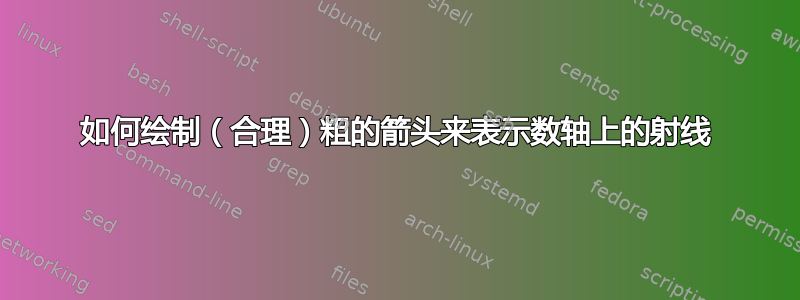
我正在尝试撰写一篇通俗易懂的论文,描述实数的最小上界性质,为此,我想引入射线的概念(在数轴上)。例如,如果我想说明小于 $r$ 的数的集合 $L_r$(其中 $r$ 是某个任意实数)。
以下是我目前得到的信息:
\usepackage{tikz}
\usepackage{pgfplots}
\pgfplotsset{compat=newest}
\documentclass{article}
\begin{document}
\begin{tikzpicture}
\begin{axis}[
axis y line=none,
axis lines=left,
axis line style={<->},
xmin=-3.2,
xmax=3.2,
ymin=0,
ymax=1,
xlabel=$r$,
xticklabel=\empty,
xmajorticks=false,
scatter/classes={a={mark=*,draw=black,fill=white}, b={mark=<,draw=black}},
restrict y to domain=0:1,
point meta=explicit symbolic,
]
\addplot[scatter,black,very thick] table [y expr=0,meta index=1, header=false]{
0 a
-3.2 b
};
\node[coordinate,label=above:{$L_r$}] at (-1.6,0.02) {};
\end{axis}
\end{tikzpicture}
\end{document}
得到如下图片:

我希望“mark=<”部分可以在数字线的左端产生一个漂亮的粗箭头,但没有那么幸运!这是我的主要目标。
次要(奖励)目标是在开放端点和伴随它的标签“r”之间留出更多一点的空间。
以防万一需要说一下,我并不是在寻找任何如此疯狂的东西:

像这样的事情更像是目标:

答案1
我想这就是你想要的。
\documentclass{article}
\usepackage{tikz}
\usetikzlibrary{arrows}
\begin{document}
\begin{tikzpicture}
\foreach \x in {-4,...,4}
\draw[shift={(\x,0)},color=black] (0pt,3pt) -- (0pt,-3pt);
\foreach \x in {-4,...,4}
\draw[shift={(\x,0)},color=black] (0pt,0pt) -- (0pt,-3pt) node[below]
{$\x$};
\draw [thin,black,stealth-stealth] (-5,0) -- (5,0);
\draw[very thick,black,-{stealth[scale=100]}] (2,0) -- (-5,0) node[fill=white,draw=black,circle, inner sep=2pt] at (2,0) {};
\draw (2,-0.5) node[anchor=north] {$r$};
\draw (-2,0.5) node[anchor=south] {$L_r$};
\coordinate (origin) at (0,0);
\end{tikzpicture}
\end{document}
答案2
因此,这里有一个快速的解决方案,在普通的 Ti钾Z。
请注意,Circle箭头的尖端应该在坐标之后开始,因此我对尖端长度进行了两倍的调整。
\documentclass[tikz,border=3.14mm]{standalone}
\usetikzlibrary{arrows.meta}
\begin{document}
\begin{tikzpicture}
\draw (-4.5,0) -- (4.5,0);
\foreach \i in {-4,...,4} \draw (\i,0.1) --++ (0,-0.2) node[below] {\strut $\i$};
\draw[Circle-Latex,line width=2pt] (2cm-4pt,0) -- (5,0);
\end{tikzpicture}
\end{document}




